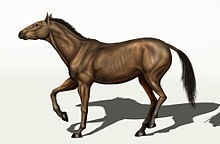| Equus conversidens Temporal range: 2.588–0.009 Ma PreꞒ Ꞓ O S D C P T J K Pg N ↓ | |
|---|---|

| |
| Scientific classification | |
| Domain: | Eukaryota |
| Kingdom: | Animalia |
| Phylum: | Chordata |
| Class: | Mammalia |
| Order: | Perissodactyla |
| Family: | Equidae |
| Genus: | Equus |
| Subgenus: | incertae sedis |
| Species: | †E. conversidens |
| Binomial name | |
| †Equus conversidens Owen, 1869 | |
| Synonyms | |
Equus conversidens, or the Mexican horse, was a Pleistocene species of horse, now extinct, that inhabited North America.

The holotype of Equus conversidens, a partial palate, was unearthed in Pleistocene deposits northeast of Mexico City, Mexico. In January 1963, a partial skeleton was found in the city of Canyon, Texas in a white clay bed during the excavation of a basement, and was referred to E. conversidens by Dalquest and Hughes (1965), who interpreted the species as medium to small-sized, and added additional records of the species from Texas (including a skeleton from Slaton), Arizona, New Mexico, Oklahoma, Kansas and Florida, synonymizing Equus francisci, Equus tau, E. littoralis, E. achates, and E. barcenaei with E. conversidens.
Criticism
Winans (1985) and MacFadden (1992) challenged the validity of E. conversidens due to its minimal diagnostic value, and treated E. francisci as valid. Heintzman, et al. (2017) argue that it is in not a member of the Equus genus.
See also
References
- ^ Equus conversidens Owen, 1869 in GBIF Secretariat (2017). GBIF Backbone Taxonomy. Checklist dataset https://doi.org/10.15468/39omei accessed via https://www.gbif.org/species/4969230 on 2019-01-17.
- ^ "†Equus conversidens Owen 1869 (horse)". Fossilworks. Retrieved 17 January 2019.
- Dalquest, Walter W.; Hughes, Jack T. (1965). "The Pleistocene Horse, Equus conversidens". The American Midland Naturalist. 74 (2): 408–417. doi:10.2307/2423270. ISSN 0003-0031. JSTOR 2423270.
- Winans, M.C. 1985. Revision of North American fossil species of the genus Equus (Mammalia:Perissodactyla:Equidae). Unpublished PhD dissertation. Austin: University ofTexas, Austin, Texas. 264 pp.
- MacFadden, B.J. 1992. Fossil horses: systematics, paleobiology, and evolution of the family Equidae. Cambridge: Cambridge University Press. 369 p.
- Heintzman, Peter D; Zazula, Grant D; MacPhee, Ross DE; Scott, Eric; Cahill, James A; McHorse, Brianna K; Kapp, Joshua D; Stiller, Mathias; Wooller, Matthew J; Orlando, Ludovic; Southon, John; Froese, Duane G; Shapiro, Beth (2017-11-28). Perry, George H (ed.). "A new genus of horse from Pleistocene North America". eLife. 6: e29944. doi:10.7554/eLife.29944. ISSN 2050-084X. PMC 5705217. PMID 29182148.
| Taxon identifiers | |
|---|---|
| Equus conversidens | |